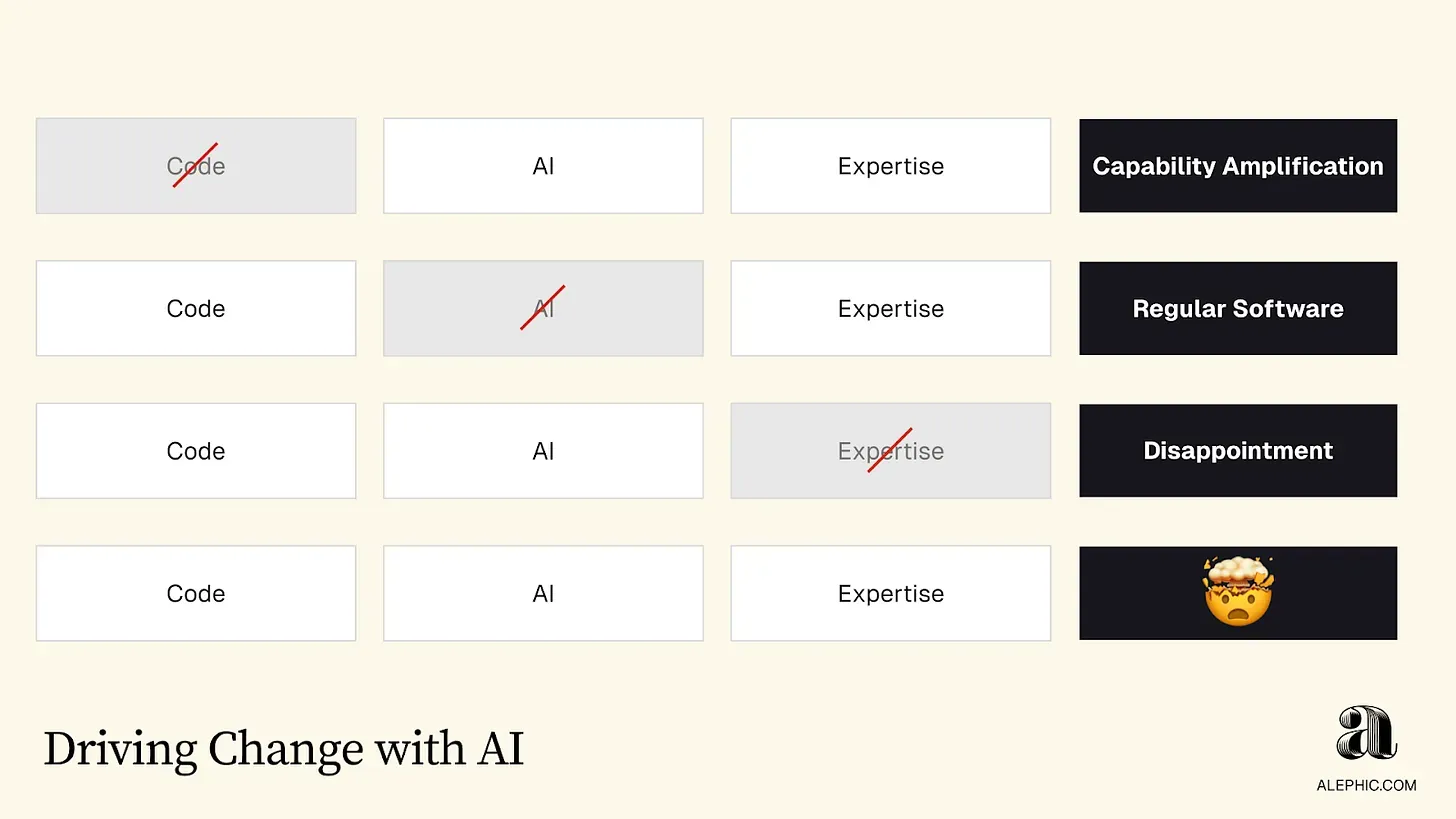At Alephic, we've discovered that driving meaningful change with AI requires understanding two crucial frameworks. The first shows what happens when key components of AI transformation intersect—or don't.

Alephic Newsletter
Our company-wide newsletter on AI, marketing, and building software.
Subscribe to receive all of our updates directly in your inbox.
The intersection of AI, Code, and Expertise
When we look at AI transformation, we see four potential scenarios:
- AI + Expertise (No Code): Creates capability amplification, but lacks scalable, repeatable processes
- Code + Expertise (No AI): Delivers traditional software solutions, limited by rigid, deterministic structures
- Code + AI (No Expertise): Results in disappointment - average outputs without specialized knowledge or strategic direction
- AI + Code + Expertise: Unlocks transformative value by combining all three elements into a powerful system for change
But understanding these intersections isn't enough. To successfully implement change, we also need to consider the human elements that make transformation possible. This brings us to our second framework:

A framework for implementing change
This framework was inspired by something similar from the world of business, but was built up primarily in education, where change is desperately needed and hard fought. "It has been said that trying to create a significant shift in paradigm in the public schools is like trying to move a graveyard," explained Timothy Knoster in a 1993 report for a public school system in Pennsylvania. "You are always amazed at how many friends the dead still have. Managing significant change is, at best, a demanding job. At worst it can serve as a proving ground for martyrs." The same holds especially true as organizations grapple with AI transformation. Change is hard, organizations grapple with AI transformation. Change is hard, and compounding that challenge, many who attempt to implement AI change come to over rely on the technology's ability to transform people and culture. If companies invest in AI to change the way they work (which they increasingly do), most believe it's 70% a technical problem and 30% a cultural one. But our experience shows it's almost always exactly the opposite.
The components of successful change implementation include:
- Vision: The "why" of change. A broader explanation for what's happening, why AI matters to your organization, and what the long-term results will be when the transformation is accomplished.
- Skills: The "how" of change. These are the specific tactics, approaches, and knowledge necessary to deliver on AI transformation. They can range from how to effectively prompt an LLM to how to build out an AI-enhanced marketing strategy and share it across teams.
- Incentives: Another take on the "why" of change. If vision is global then incentives are local. It's the answer to the all important "what's in it for me" (WIIFM) question - particularly crucial when teams might feel threatened by AI.
- Resources: This represents the network of support available to help drive AI change forward. Those could be the AI specialists responsible, the tools and models available, and even the time at your disposal to experiment and learn.
- Action Plan: The timing and tasks needed to deliver on the vision. Without lining this up and making it available to everyone involved it's easy to lose momentum and send yourselves back to the start (hence "false starts" as the negative outcome).
Successful AI transformation requires mastery of both frameworks. You need the right combination of AI, code, and expertise, but you also need the organizational elements that make change possible. Miss either piece, and you'll likely encounter resistance, disappointment, or outright failure. But when you get both right - when you combine the technical trinity with effective change management - you create the conditions for transformative success.